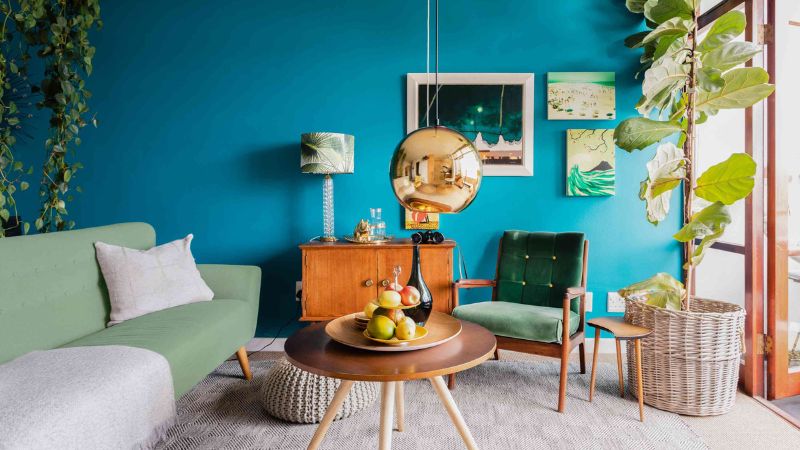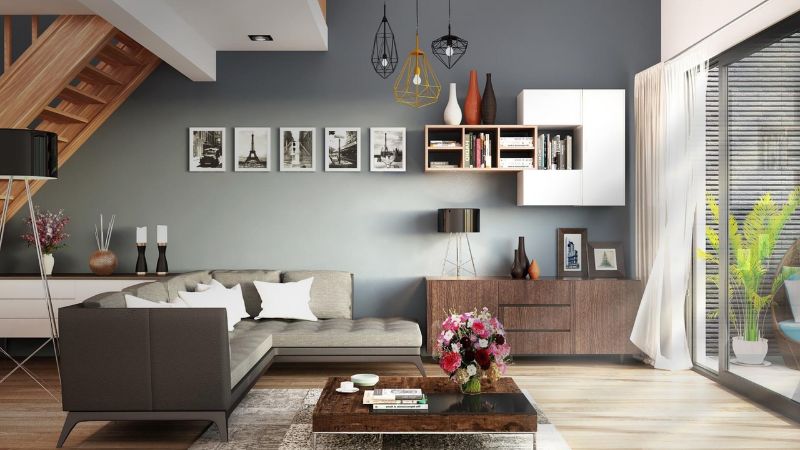In the realm of modern interior design, selecting the right color scheme is akin to choosing the perfect canvas upon which your home’s ambiance and style will be painted. Each color holds the power to influence mood, perception, and even functionality within a space. Whether you lean towards minimalist chic, industrial allure, or cozy comfort, the colors you choose can define the character of your living environment. This guide explores nine dynamic color schemes tailored for modern interiors, offering inspiration and practical tips to help you create spaces that are both aesthetically pleasing and harmoniously balanced.
Color Schemes For Modern Interior Design
Monochromatic Elegance

Monochromatic color schemes are a timeless choice for modern interior design, focusing on variations of a single color throughout a space. Several tints, hues, and tones within the same color family are used in this method to provide a unified and harmonious appearance. For example, a monochromatic scheme in shades of blue can range from deep navy to pale sky blue, creating a serene and sophisticated atmosphere. This simplicity not only makes rooms feel more spacious and unified but also allows for easy integration of textures and patterns without overwhelming the senses. Monochromatic schemes are versatile, suitable for any room in the house, from bedrooms to living areas, offering a chic and elegant aesthetic that stands the test of time.
Also Read:- Latest Trends In Kitchen Interior Design
Bold Contrasts
Bold contrast color schemes utilize striking combinations like black and white or intense hues paired with vibrant accents. These schemes create visual interest and drama, making them perfect for modern interiors that aim to make a statement. Contrast can be achieved through walls, furniture, and accessories, emphasizing architectural features and creating focal points in a room. For instance, pairing deep charcoal walls with crisp white trim enhances the modernity of a space, while adding pops of red or yellow through pillows or artwork adds energy and personality. Bold contrast schemes are ideal for those looking to create a dynamic and visually stimulating environment that reflects contemporary design trends.
Natural Neutrals
Neutral color schemes, such as beige, taupe, ivory, and gray, are perennial favorites in modern interior design for their versatility and timeless appeal. These colors provide a soothing backdrop that complements a wide range of furnishings and decor styles, from minimalist to rustic. Natural neutrals create a sense of calm and serenity, making them perfect for bedrooms, bathrooms, and living rooms where relaxation is key. They also reflect light effectively, making spaces feel larger and more airy. By layering different textures and materials in similar tones, such as linen upholstery and wool rugs in shades of cream and beige, you can add depth and interest to a neutral color scheme without compromising its understated elegance.
Earthy Tones
Earthy color schemes draw inspiration from nature, featuring hues like terracotta, olive green, mustard yellow, and warm browns. These colors bring a sense of warmth, comfort, and connection to the outdoors into modern interiors. Earthy tones work particularly well in spaces designed to be cozy and inviting, such as family rooms and dining areas. They can be paired with natural materials like wood and stone to enhance their organic feel, creating a harmonious balance between the built environment and the natural world. Incorporating plants and botanical prints further reinforces the earthy theme, bringing a touch of nature indoors and promoting a sense of well-being.
Cool Blues and Greens

Cool blues and greens evoke a sense of tranquility and freshness, reminiscent of the sky, water, and lush foliage. These colors are ideal for creating a serene and calming atmosphere in bedrooms, bathrooms, and home offices. Shades like aqua, teal, and sage green can be used as accents or as the main color in a room, depending on the desired effect. Cool colors are known for their ability to visually expand a space and create a relaxing ambiance, making them a popular choice for modern interiors that prioritize comfort and mindfulness. Pairing cool blues and greens with crisp white trim and natural wood accents enhances their refreshing appeal while maintaining a contemporary aesthetic.
Pastel Palette
Pastel color schemes feature soft, muted shades like blush pink, mint green, lavender, and light blue. These gentle hues lend a sense of lightness and airiness to modern interiors, making them perfect for rooms where a subtle touch of color is desired. Pastels are inherently soothing and create a sense of harmony and tranquility, making them ideal for bedrooms, nurseries, and reading nooks. They can be combined with neutral tones like gray or beige to create a sophisticated and understated look, or layered with deeper shades for a more eclectic and playful vibe. Pastel color schemes are versatile and can adapt to various design styles, from Scandinavian minimalism to vintage-inspired decor.
Industrial Chic
Industrial color schemes draw inspiration from urban environments and feature shades like charcoal gray, metallic silver, and weathered blues. These colors reflect the raw and utilitarian aesthetic of industrial spaces, making them ideal for modern lofts, converted warehouses, and urban apartments. Industrial chic interiors often incorporate materials like exposed brick, concrete, and metal accents to enhance their rugged appeal. The color palette is typically neutral with occasional pops of bold colors like red or yellow to add contrast and visual interest. Authenticity and utility are celebrated in industrial chic design, which also embraces flaws and highlights the beauty of raw materials in their original condition.
Pop of Color
Pop of color schemes involve using bold and vibrant hues to create focal points or add personality to modern interiors. These schemes often feature a neutral base with accents of bright colors like cobalt blue, fiery red, citrus orange, or sunny yellow. The key to a successful pop of color scheme is balance—using vibrant shades sparingly to prevent overwhelming the space while creating visual interest and energy. Popular applications include accent walls, statement furniture pieces, or decorative accessories such as pillows, rugs, and artwork. Pop of color schemes are perfect for homeowners who want to inject personality and excitement into their living spaces without committing to a complete overhaul of their decor.
Warm and Cool Contrast

Warm and cool contrast schemes combine warm hues like rust orange, mustard yellow, or deep red with cool tones such as teal, navy blue, or slate gray. This juxtaposition creates a balanced and inviting atmosphere in modern interiors, blending the comforting warmth of earth tones with the refreshing coolness of blues and greens. These schemes are versatile and can be adapted to different rooms and design styles, from eclectic bohemian to minimalist chic. By strategically placing warm and cool colors throughout a space, you can create visual depth and dimension while maintaining a cohesive and harmonious overall look. Warm and cool contrast schemes are ideal for homeowners who appreciate a balanced approach to color and want to create a welcoming and stylish environment in their homes.
Also Read:- Vintage Interior Design Ideas
Conclusion
Selecting the perfect color scheme for your modern interior design isn’t just about aesthetics—it’s about creating an environment that reflects your personality, enhances functionality, and promotes a sense of well-being. Whether you prefer the understated elegance of neutrals or the bold statement of contrasting hues, the right colors can transform your home into a haven of style and comfort. Experiment with different combinations, consider the mood you want to evoke in each room, and enjoy the transformative power of color as you design spaces that truly inspire.
FAQs
Which color scheme works best for small rooms?
Light, neutral tones such as soft grays or beige are ideal for small rooms as they reflect light and create an illusion of space, making the room feel more open and airy.
How can I ensure my chosen color scheme enhances the overall ambiance of my home?
Consider the natural light, room size, and function when selecting colors. Create cohesion by using a dominant color for walls and large surfaces, and incorporate accents in complementary shades throughout the space to tie the room together.


